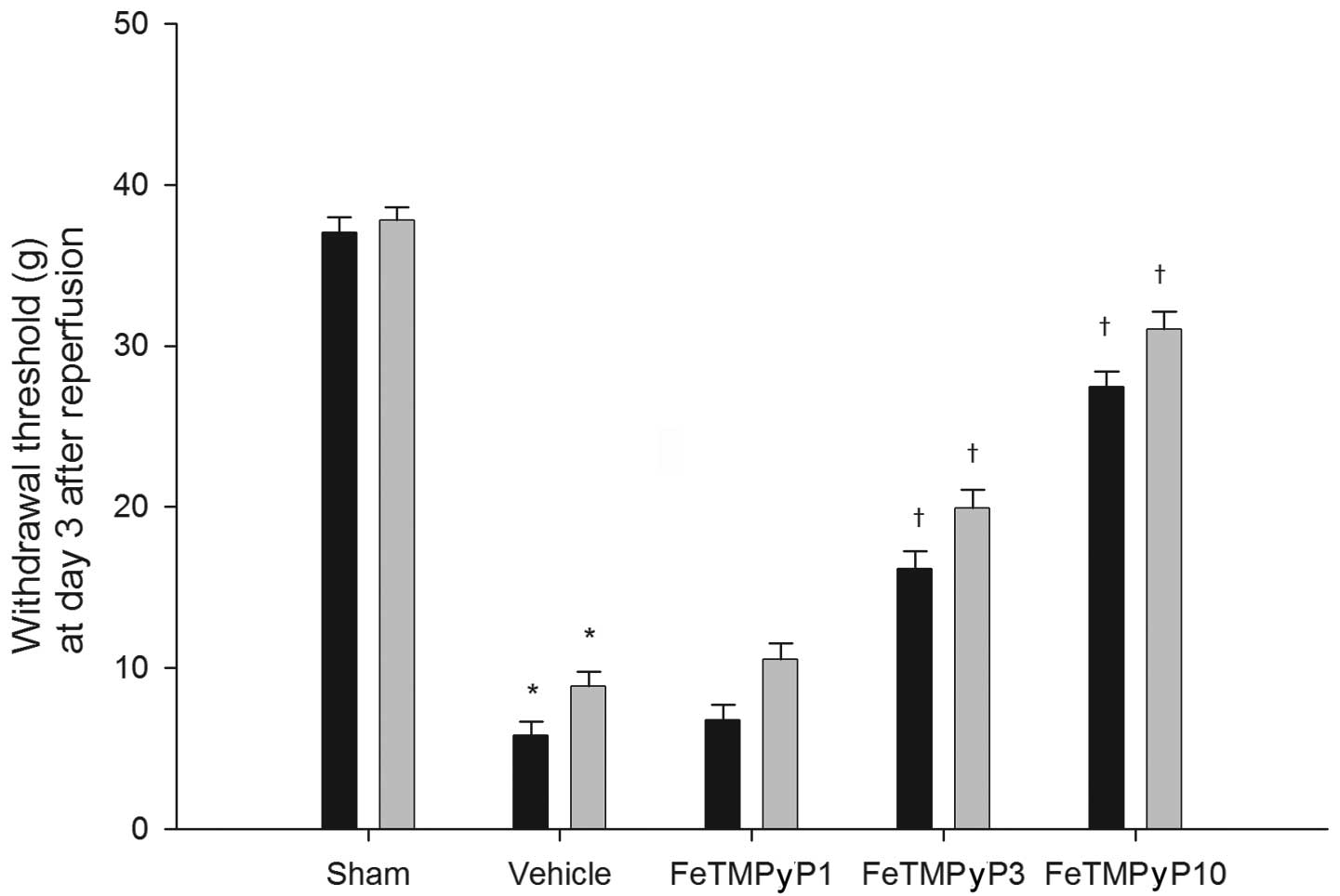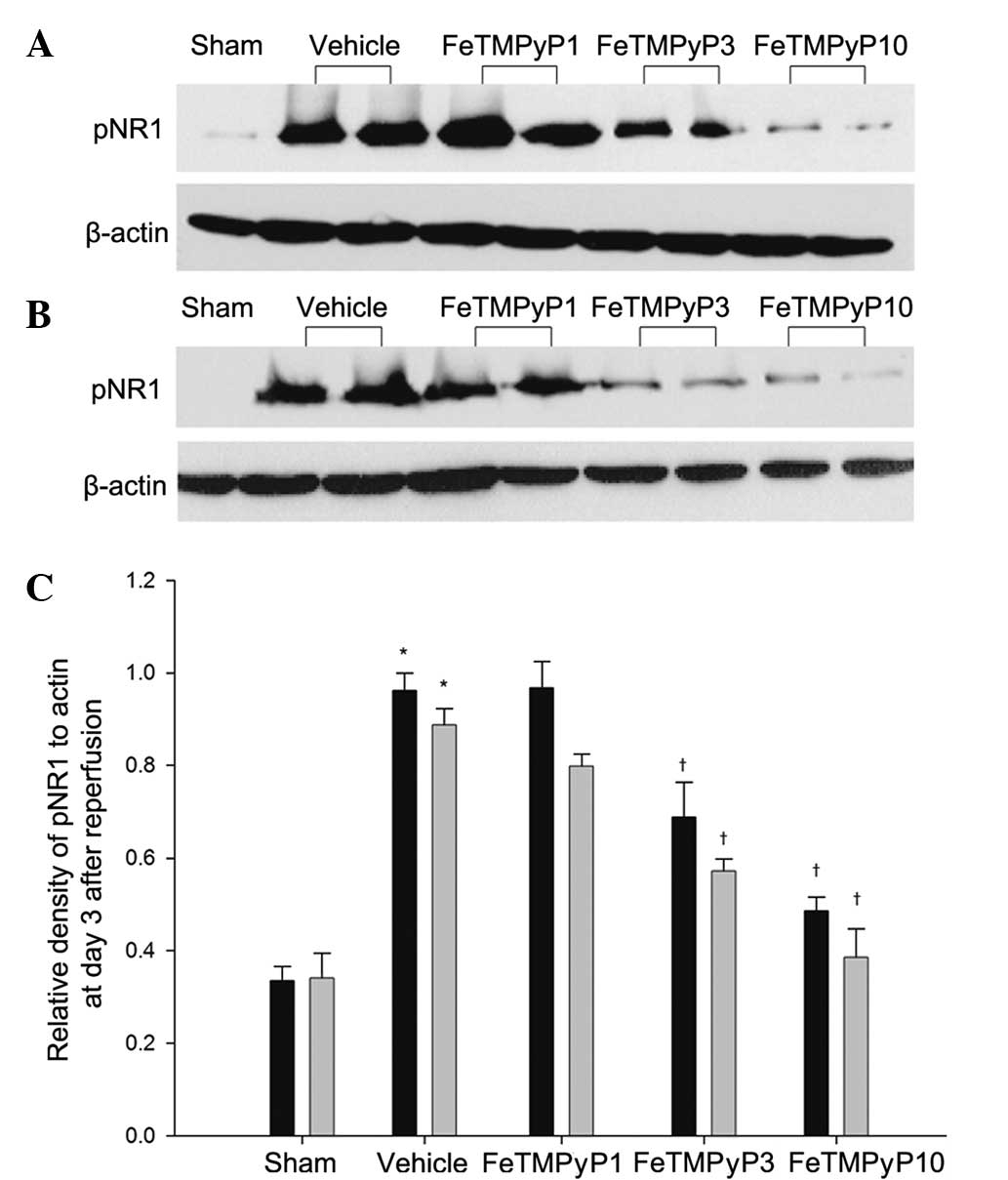|
1
|
Bruehl S: An update on the pathophysiology
of complex regional pain syndrome. Anesthesiology. 113:713–725.
2010.PubMed/NCBI
|
|
2
|
Eisenberg E, Shtahl S, Geller R, et al:
Serum and salivary oxidative analysis in complex regional pain
syndrome. Pain. 138:226–232. 2008. View Article : Google Scholar : PubMed/NCBI
|
|
3
|
Zollinger PE, Tuinebreijer WE, Breederveld
RS and Kreis RW: Can vitamin C prevent complex regional pain
syndrome in patients with wrist fractures? A randomized,
controlled, multicenter dose-response study. J Bone Joint Surg Am.
89:1424–1431. 2007. View Article : Google Scholar : PubMed/NCBI
|
|
4
|
Coderre TJ, Xanthos DN, Francis L and
Bennett GJ: Chronic post-ischemia pain (CPIP): a novel animal model
of complex regional pain syndrome-type I (CRPS-I; reflex
sympathetic dystrophy) produced by prolonged hindpaw ischemia and
reperfusion in the rat. Pain. 112:94–105. 2004. View Article : Google Scholar
|
|
5
|
Kwak KH, Han CG, Lee SH, et al: Reactive
oxygen species in rats with chronic post-ischemia pain. Acta
Anaesthesiol Scand. 53:648–656. 2009. View Article : Google Scholar : PubMed/NCBI
|
|
6
|
Rodrigo J, Fernandez AP, Serrano J,
Peinado MA and Martinez A: The role of free radicals in cerebral
hypoxia and ischemia. Free Radic Biol Med. 39:26–50. 2005.
View Article : Google Scholar : PubMed/NCBI
|
|
7
|
Szabó C: Multiple pathways of
peroxynitrite cytotoxicity. Toxicol Lett. 140–141:105–112.
2003.
|
|
8
|
Beckman JS, Chen J, Crow JP and Ye YZ:
Reactions of nitric oxide, superoxide and peroxynitrite with
superoxide dismutase in neurodegeneration. Prog Brain Res.
103:371–380. 1994. View Article : Google Scholar : PubMed/NCBI
|
|
9
|
Radi R, Beckman JS, Bush KM and Freeman
BA: Peroxynitrite-induced membrane lipid peroxidation: the
cytotoxic potential of superoxide and nitric oxide. Arch Biochem
Biophys. 288:481–487. 1991. View Article : Google Scholar : PubMed/NCBI
|
|
10
|
Mabley JG, Liaudet L, Pacher P, Southan
GJ, Groves JT, Salzman AL and Szabó C: Part II: beneficial effects
of the peroxynitrite decomposition catalyst FP15 in murine models
of arthritis and colitis. Mol Med. 8:581–590. 2002.PubMed/NCBI
|
|
11
|
Cuzzocrea S, Mazzon E, Di Paola R,
Esposito E, Macarthur H, Matuschak GM and Salvemini D: A role for
nitric oxide-mediated peroxynitrite formation in a model of
endotoxin-induced shock. J Pharmacol Exp Ther. 319:73–81. 2006.
View Article : Google Scholar : PubMed/NCBI
|
|
12
|
Pacher P, Beckman JS and Liaudet L: Nitric
oxide and peroxynitrite in health and disease. Physiol Rev.
87:315–424. 2007. View Article : Google Scholar : PubMed/NCBI
|
|
13
|
Torreilles F, Salman-Tabcheh S, Guérin M
and Torreilles J: Neurodegenerative disorders: the role of
peroxynitrite. Brain Res Brain Res Rev. 30:153–163. 1999.
View Article : Google Scholar : PubMed/NCBI
|
|
14
|
Ndengele MM, Cuzzocrea S, Esposito E,
Mazzon E, Di Paola R, Matuschak GM and Salvemini D: Cyclooxygenases
1 and 2 contribute to peroxynitrite-mediated inflammatory pain
hypersensitivity. FASEB J. 22:3154–3164. 2008. View Article : Google Scholar : PubMed/NCBI
|
|
15
|
Liu T, Knight KR and Tracey DJ:
Hyperalgesia due to nerve injury-role of peroxynitrite.
Neuroscience. 97:125–131. 2000. View Article : Google Scholar
|
|
16
|
Muscoli C, Cuzzocrea S, Ndengele MM, et
al: Therapeutic manipulation of peroxynitrite attenuates the
development of opiate-induced antinociceptive tolerance in mice. J
Clin Invest. 117:3530–3539. 2007. View
Article : Google Scholar : PubMed/NCBI
|
|
17
|
Ndengele MM, Cuzzocrea S, Masini E, et al:
Spinal ceramide modulates the development of morphine
antinociceptive tolerance via peroxynitrite-mediated nitroxidative
stress and neuroimmune activation. J Pharmacol Exp Ther. 329:64–75.
2009. View Article : Google Scholar
|
|
18
|
Muscoli C, Mollace V, Wheatley J, Masini
E, Ndengele M, Wang ZQ and Salvemini D: Superoxide-mediated
nitration of spinal manganese superoxide dismutase: a novel pathway
in N-methyl-D-aspartate-mediated hyperalgesia. Pain. 111:96–103.
2004. View Article : Google Scholar
|
|
19
|
Guo W, Zou S, Guan Y, Ikeda T, Tal M,
Dubner R and Ren K: Tyrosine phosphorylation of the NR2B subunit of
the NMDA receptor in the spinal cord during the development and
maintenance of inflammatory hyperalgesia. J Neurosci. 22:6208–6217.
2002.PubMed/NCBI
|
|
20
|
Zou X, Lin Q and Willis WD: Enhanced
phosphorylation of NMDA receptor 1 subunits in spinal cord dorsal
horn and spinothalamic tract neurons after intradermal injection of
capsaicin in rats. J Neurosci. 20:6989–6997. 2000.
|
|
21
|
Gao X, Kim HK, Chung JM and Chung K:
Reactive oxygen species (ROS) are involved in enhancement of
NMDA-receptor phosphorylation in animal models of pain. Pain.
131:262–271. 2007. View Article : Google Scholar : PubMed/NCBI
|
|
22
|
Stanton-Hicks M, Jänig W, Hassenbusch S,
Haddox JD, Boas R and Wilson P: Reflex sympathetic dystrophy:
changing concepts and taxonomy. Pain. 63:127–133. 1995. View Article : Google Scholar : PubMed/NCBI
|
|
23
|
Beckman JS, Beckman TW, Chen J, Marshall
PA and Freeman BA: Apparent hydroxyl radical production by
peroxynitrite: implications for endothelial injury from nitric
oxide and superoxide. Proc Natl Acad Sci USA. 87:1620–1624. 1990.
View Article : Google Scholar : PubMed/NCBI
|
|
24
|
Goldstein S and Czapski G: The reaction of
NO• with O2•− and
HO2•: a pulse radiolysis study. Free Radic
Biol Med. 19:505–510. 1995.
|
|
25
|
Beckman JS and Crow JP: Pathological
implications of nitric oxide, superoxide and peroxynitrite
formation. Biochem Soc Trans. 21:330–334. 1993.PubMed/NCBI
|
|
26
|
Crow JP and Beckman JS: The role of
peroxynitrite in nitric oxide-mediated toxicity. Curr Top Microbiol
Immunol. 196:57–73. 1995.PubMed/NCBI
|
|
27
|
Cuzzocrea S, Zingarelli B, Hake P, Salzman
AL and Szabó C: Antiinflammatory effects of mercaptoethylguanidine,
a combined inhibitor of nitric oxide synthase and peroxynitrite
scavenger, in carrageenan-induced models of inflammation. Free
Radic Biol Med. 24:450–459. 1998. View Article : Google Scholar
|
|
28
|
Salvemini D, Wang ZQ, Wyatt PS, Bourdon
DM, Marino MH, Manning PT and Currie MG: Nitric oxide: a key
mediator in the early and late phase of carrageenan-induced rat paw
inflammation. Br J Pharmacol. 118:829–838. 1996. View Article : Google Scholar : PubMed/NCBI
|
|
29
|
Salvemini D, Little JW, Doyle T and
Neumann WL: Roles of reactive oxygen and nitrogen species in pain.
Free Radic Biol Med. 51:951–966. 2011. View Article : Google Scholar : PubMed/NCBI
|
|
30
|
Drel VR, Pacher P, Vareniuk I, et al: A
peroxynitrite decomposition catalyst counteracts sensory neuropathy
in streptozotocin-diabetic mice. Eur J Pharmacol. 569:48–58. 2007.
View Article : Google Scholar : PubMed/NCBI
|
|
31
|
Obrosova IG, Drel VR, Oltman CL, Mashtalir
N, Tibrewala J, Groves JT and Yorek MA: Role of nitrosative stress
in early neuropathy and vascular dysfunction in
streptozotocin-diabetic rats. Am J Physiol Endocrinol Metab.
293:E1645–E1655. 2007. View Article : Google Scholar : PubMed/NCBI
|
|
32
|
Radi R: Nitric oxide, oxidants, and
protein tyrosine nitration. Proc Natl Acad Sci USA. 101:4003–4008.
2004. View Article : Google Scholar : PubMed/NCBI
|
|
33
|
Wang Z, Porreca F, Cuzzocrea S, et al: A
newly identified role for superoxide in inflammatory pain. J
Pharmacol Exp Ther. 309:869–878. 2004. View Article : Google Scholar : PubMed/NCBI
|
|
34
|
Trotti D, Rossi D, Gjesdal O, Levy LM,
Racagni G, Danbolt NC and Volterra A: Peroxynitrite inhibits
glutamate transporter subtypes. J Biol Chem. 271:5976–5979. 1996.
View Article : Google Scholar : PubMed/NCBI
|
|
35
|
Görg B, Wettstein M, Metzger S, Schliess F
and Häussinger D: Lipopolysaccharide-induced tyrosine nitration and
inactivation of hepatic glutamine synthetase in the rat.
Hepatology. 41:1065–1073. 2005.PubMed/NCBI
|
















